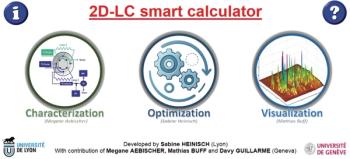
- The Column-12-05-2017
- Volume 13
- Issue 17
Get More Separation Power With Multidimensional Chromatography
Multidimensional chromatography, or comprehensive chromatography, is a well-established technique for the analysis of complex mixtures. However, the technique is often perceived as highly complex and difficult to put into practice for routine applications. Nonetheless, the technique provides exceptional potential for addressing challenging separations. The addition of a dilution factor allows multidimensional chromatography to provide a high level of flexibility and selectivity. The dilution effect is achieved by using a column chemistry format compatible with large flow rates, which now offers the option of large volume injection without volume or mass overload issues. This novel solution can reduce or eliminate the need to add a solvent exchange step, such as evaporation or reconstitution, which significantly reduces the most time-consuming part of the sample preparation process.
Claude Mallet, Waters Corporation, Milford, Massachusetts, USA
Multidimensional chromatography, or comprehensive chromatography, is a well-established technique for the analysis of complex mixtures. However, the technique is often perceived as highly complex and difficult to put into practice for routine applications. Nonetheless, the technique provides exceptional potential for addressing challenging separations. The addition of a dilution factor allows multidimensional chromatography to provide a high level of flexibility and selectivity. The dilution effect is achieved by using a column chemistry format compatible with large flow rates, which now offers the option of large volume injection without volume or mass overload issues. This novel solution can reduce or eliminate the need to add a solvent exchange step, such as evaporation or reconstitution, which significantly reduces the most time-consuming part of the sample preparation process. Effective detector sensitivity can also be improved by as much as one hundred times with this time de-coupled chromatographic approach.
Liquid chromatography (LC), gas chromatography (GC), and supercritical fluid chromatography (SFC) are premium techniques for routinely separating and analyzing sample components in a wide range of matrices. Single stage (1) or singleâdimensional chromatography is currently the predominant separation technique for various applications and is defined, according to Marriot et al. (2), as a separation method using a basic affinity mechanism (stationary and mobile phase) for component separation.
Beginning with the discovery work of Tswett (3) and development work of Martin and Synge (4), chromatography matured rapidly after the introduction of instrumental techniques in the early 1970s and has become the technique of choice to solve a wide range of analytical challenges. Where it comes up short, however, is with complex sample extracts-ones containing hundreds of individual analytes. For samples like these, qualitative and quantitative analysis is very difficult, if not impossible. This is a problem linked to the fact that sample extracts like this contain a wide range of components and a huge number of individual sample components.
For any given extraction protocol, the raw sample matrix undergoes a series of extraction steps, which may require several extraction techniques to produce a sample suitable for chromatographic analysis. The resulting extract is usually given a low-, intermediate-, or highâcomplexity rating. This is known as matrix complexity. In other words, for the highestâcomplexity samples, the number of individual components in a final extract far exceeds the separation power of a single chromatographic dimension to baseline resolve each and every one of them over the entire elution period.
In a recent review (5), the authors make several compelling arguments that, even with the added resolving power of LC–MS coupling, and the versatility of electrospray ionization (ESI) and structure elucidation capability of MS/MS approaches, the task of identifying all coeluting components is exceptionally challenging. Therefore, expecting orders of magnitude more separation power from an LC–MS/MS method is simply not feasible (6). The solution is multidimensional separation schemes by combining two or more separation mechanisms.
Why Add Extra Separation Dimensions?
Peak overlap is a major issue when analyzing complex extracts. To counter this problem, one solution is to increase the peak capacity or separation power (dimension-less value) of the chromatographic system. However, to resolve 98% of the sample components, according to Giddings, the peak capacity must exceed the number of components by 100-fold (7). The concept of multidimensional chromatography is considered a viable solution for the analysis of complex samples. The technique is gaining popularity at the same time that column technology seems to be close to reaching its maximum theoretical performance. This is because the peak capacity achieved with multidimensional chromatography is far greater than that of a single dimension chromatographic separation.
Multidimensional chromatography is defined by coupling two or more chromatographic separations to enhance overall resolution and separation power. Ideally, the maximum peak capacity (ηc 2D) of this type of chromatographic system is given by the product of the peak capacities in the first (ηc 1thD) and in the second (ηc 2ndD) dimension.
The pioneering work of Giddings in the late 1960s with multidimensional gas chromatography established the fundamentals for defining a multidimensional separation. As defined by Giddings in a 1967 publication, for a separation to fit the category of multidimensional it must meet two criteria: i) components must be subjected to two or more largely independent separative displacement and ii) whenever two components are resolved in any one displacement step, they will remain resolved throughout the process. The second criterion eliminates tandem arrangement of two or more columns. With a serial connection, the resolution gained in one dimension can be partially or totally lost in the subsequent column.
Multidimensional LC Workflow Overview
Now that we know what multidimensional chromatography entails, the next question is “where to begin”? This question inevitably refers to method development and identifying which key parameters are crucial for a streamlined application. The transfer of a target analyte from one chromatographic dimension to another chromatographic dimension is not a trivial task and calls for a sequence of events that will ensure a reproducible workflow.
In single-dimension chromatography, method development is typically performed with a trial-and-error approach, which ultimately leads to an optimized chromatographic method in a relatively short time. However, to optimize methods for a multidimensional chromatography workflow, a larger selection of parameters come into play. With an automated injection sequence and a selection of key parameters, a large number of methods can be screened in a short time. With an atâcolumnâdilution (ACD) workflow, four main parameters will have an impact on the transfer process between two resolving chromatography dimensions and are listed as follows: i) loading conditions, ii) elution conditions, iii) refocusing chemistries, and iv) separation chemistries. Each condition selected will have a key effect on the elution behaviour of a target analyte. With an overwhelming number of possibilities, evaluating all of them is extremely timeâconsuming and so constructing a screening strategy by selecting key variants from the top four operating parameters significantly streamlines the method development process. Those key variants are used to identify which permutations have the best chance of producing satisfactory results in the shortest amount of time (7).
Let’s take a look at the first parameter: the pH of the loading stream. The loading stream moves a target analyte from the injection loop onto the first dimension. For this separation, high pH, low pH, and neutral loading conditions were evaluated to monitor the retention efficiency versus an ionized or neutral state of the target analyte. Figure 1 shows the retention behaviour for cimetidine at low, neutral, and high pH. As seen in the bottom chromatogram, with a low pH loading stream, the target analyte shows no signal. However, at a high pH, the target analyte shows a positive signal with a peak shape showing a Gaussian distribution. Why the difference? The loading stream pH ensures that under that condition the target analyte will produce a high retention value for effective retention. In this instance, the absence of signal can be explained by sample breakthrough during the loading phase. For this particular analyte, loading under a low pH stream produced an ionized condition with low retention and ultimately led to sample breakthrough.
The second parameter involves the retention strength during the loading phase. The sorbent’s retention strength can also have an impact on a target analyte’s retention value. Figure 2 shows the retention behaviour of carbamazepine on a low-, mid-, and high-retention strength sorbent. As the top chromatogram shows, the target analyte’s chromatographic peak isn’t a classic Gaussian shape and tails at the back end, which is the result of a strong affinity for the sorbent. By comparison the Gaussian peak shape for the target analyte as seen in the bottom chromatogram is attributable to a lowâretention sorbent. The stronger an analyte binds to the sorbent during the elution phase, the less likely it is to be recovered.
A third parameter targets the elution strength. As seen in Figure 3, the atrazine elution profile suggests a high affinity of the analyte for methanol. With acetonitrile the peak tailing clearly indicates a slow release of the target analyte from the sorbent and that the concentration of organic solvent is too high for an effective refocusing on the subsequent chromatographic dimension. The loading and eluting parameters work in tandem to ensure no breakthrough during loading and minimal peak distortion during back-flush elution.
The last parameter deals with the refocusing on the last chromatographic dimension during the final phase of the transfer process. Figure 4 displays the chromatographic behaviour of corticosterone versus the hydrophobic selectivity of a UHPLC bridged ethyl hybrid silica C18 column and a UHPLC high strength silica C18 column. Overall, the separation chemistries complement the system performance by fineâtuning the level of hydrophobicity.
Which operating conditions gave the best peak profile in the shortest amount of time? For the answer to that question, a colourâcoded chart was created for easy visualization of the most suitable set of conditions. Figure 5 shows the elution profile of trimethoprim for three selected methods. The chromatogram from method 1 shows no signal for the target analyte and therefore method 1 was flagged red. The chromatogram from method 25 shows an intense signal, however, the peak shape was distorted by a peak tailing effect. Thus, method 25 was tagged yellow. The chromatogram from method 28 shows a well-resolved and Gaussian peak shape and is tagged green. With these screening criteria, each method was carefully identified and compiled for comparison achieving an 83% success rate of finding a method for quantitative analysis and 97% success rate for a qualitative analysis (screening application).
Separation of a Class C matrix
For most tissue applications, liquid–liquid extraction (LLE) and solid-phase extraction (SPE) are used for de-fatting cleanup or concentration steps (8). With more complex matrices, a more robust extraction and cleanup method is an absolute must to reach the desired target limits of detection (LOD). The analysis of xylazine and ketamine in biological tissue specimens (heart, kidney, spleen, brain, lung, and stomach) entails several analytical challenges, predominately during the extraction phase (9). As with all Class C matrices (solids), the sample must undergo a complete disruption of the cell membrane to expose the inner portion of tissue cells. Homogenization is thus the first step for extracting a target analyte into a liquid solution for further clean-up and concentration. Most laboratories still employ extensive and timeâconsuming sample preparation protocols to reach sub parts per billion (ng/mL or ppb) levels. Some of these techniques are decades-old and can create a real bottleneck. Traditional SPE techniques require a lengthy evaporation step, which will inevitably delay the completion of a forensic investigation.
The solution to this is a microextraction protocol (10) combined with multidimensional chromatography that can speed up the process without sacrificing the chromatographic fidelity of singleâdimension chromatography techniques. The homogenization process is typically performed with a common kitchen blender or using a hand-held homogenizer. However, those techniques are difficult to apply to small sample amounts. In recent years, novel ceramic or stainless steel ball bearings combined with variable speed orbital shakers have been shown to homogenize 0.1 g to 5 g of sample and achieve complete cell membrane breakdown in less than 60 s. For our experiment, the weight of the rat brain, heart, lung, liver, kidney, and spleen sample was between 0.2 g and 0.8 g. Once homogenized, the sample is centrifuged, creating a solid pellet on the bottom of the tube with the organic supernatant above. The organic supernatant is then decanted, diluted at 5% organic content, and extracted by SPE. With a two-dimensional (2D)âLC workflow, the ketamine and xylazine extraction in rat tissues was completed in 30 min. The quantification limit was set at 50 ppt using a 1 g sample. The microextraction protocol allows one the option of evaluating several elution parameters in a short time period. The elution optimization was completed within 4 h and the optimization was completed during an overnight run using a multiâmethod grid (18 h). The final extraction protocol produced a clean extract without any evaporation to dryness and reconstitution into initial mobile phase conditions. The mixed-mode extraction protocol achieved an average 90% recovery for both drugs.
Conclusion
For busy laboratories seeking improvements in efficiency, multidimensional chromatography is fast becoming a viable option for separating minute concentrations of drugs in small amounts of human tissue. The impact of the deployment of multidimensional LC will be seen not at the instrument level, but at the overall workflow level. By automating the method development process, miniaturizing sample extraction, and by minimizing or eliminating any need to add a solvent exchange step (evaporation or reconstitution) significant improvements in quantitative accuracy, detection sensitivity, and overall time to result can be achieved.
References
- H.J. Cortes, J. Chromatogr. 626, 3–23 (1992).
- P.J. Marriott and D. Ryan, Chromatography | Multidimensional Techniques, 105–112 (2005).
- L.S. Ettre and K.I. Sakadynskii, Chromatographia 35, 329–338 (1993).
- A.J.P. Martin and R.L.M. Synge, J. Bio. Chem. 155, 535–546 (1944).
- G. Guiochon, J. Chromatogr. A1126, 6 (2006).
- J.C. Giddings, J. Chromatogr. A 703, 3 (1995).
- C.R. Mallet and S. Botch-Jones, Illicit Drug Analysis in Urine Using 2D LC-MS/MS for Forensic Toxicology, Waters 720005533EN (2017).
- G.R. Jones, in Clarke’s Analytical Forensic Toxicology, A. Negrusz and G Cooper, Eds. (Pharmaceutical Press, London, UK, 2013), pp. 189–213.
- J.H. Watterson and J.P. Donohue, J. of Anal. Tox. 35(7), 452–458 (2011).
- M. Mella, B. Schweitzer, S. Botch-Jones, and C.R. Mallet, Analysis of Ketamine and Xylazine in Rat Tissues Using ACQUITY UPLC with 2D Technology, Waters 720005810EN, (2016).
Claude Mallet received his Ph.D. in analytical chemistry from the University of Montreal, Montreal, Canada, in 1997. His Ph.D. thesis was entitled “Time-CoupledâTimed-Resolved Chromatography”. This new hyphenated system was based on experimental GC–GC–MS/MS orthogonal chromatography using a mobile heated pulse. Claude joined Waters Corporation as a senior scientist in 2000. He has authored several peerâreviewed papers and presented innovative research at international conferences. With the creation of the WorkFlow Integration Group in 2013, he is currently conducting research in the field of novel multidimensional chromatography platforms.
E-mail:
Articles in this issue
about 8 years ago
Instrumental Innovations 2017about 8 years ago
Peak Introduces Free to Use GC Gas Calculatorabout 8 years ago
Kevin Schug Earns ACS Education Excellence Awardabout 8 years ago
Dwight Stoll Receives EAS Young Investigator Awardabout 8 years ago
Sciex Announce China Expansionabout 8 years ago
Tips & Tricks GPC/SEC: How to Treat Your RI Detectorabout 8 years ago
The Durian Tang: Investigating the World’s Smelliest Fruitabout 8 years ago
Vol 13 No 17 The Column December 05, 2017 Europe and Asia PDFNewsletter
Join the global community of analytical scientists who trust LCGC for insights on the latest techniques, trends, and expert solutions in chromatography.





